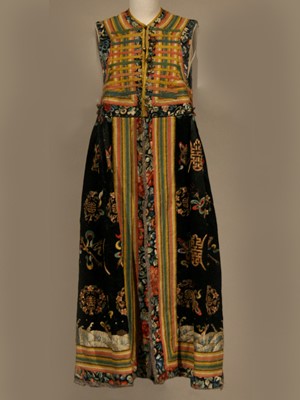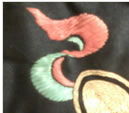The traditional clothes of the Chinese are not only extraordinary in their physical creation, but they are meaningful in their symbolism. The court vest in the Nowes Ark Collection, as seen below in Figure 1 is an excellent example. It is made from silk and cotton.
Figure 1: Court Vest |
I |
This court vest was created during the close of the Xing Dynasty near the end of the 19th century. Although it has withered with age, this garment exemplifies the refinement and luxury of the upper classes in China. This vest would have been worn at a court ritual by a woman of high-rank in society, as the outer layer of an elaborate ensemble.
The construction would have taken many months because this garment is entirely hand-made. The court vest has a fitted bodice that would hug the body of the wearer when closed at its center front opening. The seam at the natural waist line joins the bodice to the fuller pleated skirt. The skirt is open at center front and center back from the waist to the floor. It is made mainly from silk. The primary fabric is a deep blue silk satin and lined with a lighter shade of blue. Wear over time has caused a rip in the lining in various places making it possible to see a blue interlayer in the bodice and a pink interlayer in the skirt which added structure to the garment. Further rigidity was created by applying a stiffening substance to the interlayer. This substance is now flaking, due to age.
The fitted part of the bodice is silk over which finished cotton strips have been sewn in a lattice pattern. The fastening at center front is comprised of braided cotton tapes that cross over the ones that border the center front opening. These tapes form loops, creating frogs that are connected to metal toggles on the right side. Other loops and toggles made by braided green and white cotton tapes and round metal toggles are on the inside lining of the garment, hidden from sight. This fastening method was common among nomadic peoples from whom the Manchurians were descended. More loops and toggles are found around in various places on the vest, adding to the decorative charm and overall complexity of the garment. Toggle loops can be found below the arm hole with coin shaped disks attached to them. These have no practical use and are for aesthetic appeal. Another toggle loop is found at the nape of the neck with a long string handing from it. There is no button or frog there but it can be assumed that there was previously either a round metal frog like the toggles at the breast or a coin shaped button like the ones found near the arm holes. Similar loops are located at the top of the shoulder. During formal occasions, a separate collar could be attached at that point.
The garment has multiple borders around its edges. The outermost border is a yellow silk that rims the neckline and center front opening of the bodice. Another border follows the ending edges of the skirt portion of the garment. It is made of a blue and gold brocade tape folded over slits in the skirt as well as the hem and sewn into place. It has golden patterns of slivers of various Chinese symbols that cannot be clearly made out due to the fracturing of the silk and lack of a complete symbol. The next border consists of embroidery of an assortment of floral designs including plum blossoms, lotus blossoms, Artemisia leaves, and other various Chinese symbols. This border follows all ending edged of the fabric as well as the bottom of the bodice where the seam joins it to the skirt portion. The next layer of border follows all the same paths as the floral embroidery. This one is made of 17 different colors of braided cotton tapes.
Detailed embroidery was used in the body of the skirt as well as within the borders. Most of the embroidery was done with a satin stitch using silk floss on the blue satin background, as seen in Figure 2 below. This garment contains some examples of the eight Buddhist Emblems, which are significant objects that represent ideals of the Buddhist religion, including the endless knot, depicted in Figure 3 below, which represents the Buddhist path.
Figure 2: Detail of Satin Stitch |
Figure 3: title |
 |
 |
There is a representation of the vase on the deep blue border near the arm hole of the bodice. This emblem can be seen in Image 5 below. The vase is said to contain the elixir of heaven. Near the waist seam is a conch shell, as seen in Figure 4 blow. The conch shell was originally used to call the faithful to prayer so it symbolizes the far reaching nature of the Buddha’s teaching to awaken those who are asleep (in ignorance).
Figure 4: Conch Shell |
Figure 5: Vase |
 |
 |
The wheel of law can be found on the outer blue border of the bodice. This emblem, seen below in Figure 6, symbolizes the Buddhist doctrine that leads a follower to Enlightenment.
Figure 6: Wheel of Law |
 |
Among the Eight Precious things are Rhinoceros horns which symbolize health; they are depicted in Figure 8 below. The court vest also contains examples of the eight Daoist emblems. Each one of the eight emblems is associated with one of the Daoist Immortals and were used to summon spiritual powers. The symbol depicting a bamboo tube holding divining rods can be seen in Figure 7 below. This particular emblem is associated with the Daoist immortal Zhang Guolao.
Figure 7: Divining Rods inBamboo Tube |
Figure 8: RhinocerosHorns |
 |
 |
At the bottom of the skirt portion of the court vest is one of the most popular of the Chinese symbols: water and earth. This is seen in Figure 9 below. The billowing swells of the ocean reach all the way around the bottom of the skirt only to be interrupted by the prism shaped rocks in which the waves crash against. The water represents the universal ocean surrounding the earth and the rocks represent the earth’s mountains.
Figure 9: Water and Earth |
 |
Other Chinese symbols depicted in the body of the garment are clouds. This is a very common symbol that finds itself on almost all traditional court clothing in China. In earlier dynasties, the clouds were wispy and pointy on their ends. During the late Qing Dynasty, clouds were rounded in shape like the ones found on the court vest. They were often used to fill empty space on clothing (Chinese Dragon 56).
Figure 10: DoubleHappiness |
Figure 11: Long Life"Shou" |
 |
 |
Other important symbols on the vest include Chinese characters, among them are “shou and “xiangsi. Shou is the Chinese character for long life and can be seen above in Figure 11. Xiangsi is the Chinese character xi, meaning happiness, repeated twice and therefore known as double happiness. This symbol for good fortune and wealth is depicted above in Figure 10.
The court vest has more symbols and several of the ones identified are repeated. Together with the quality of the materials from which the robe was made and the careful embroidery stitches indicate that this was part of a formal ensemble worn to a special occasion by someone of great wealth.
© Cassandra (Cassie) Marcantonio, 2014. Drama 475.001, Spring 2014 Semester. University of North Carolina at Chapel Hill.

